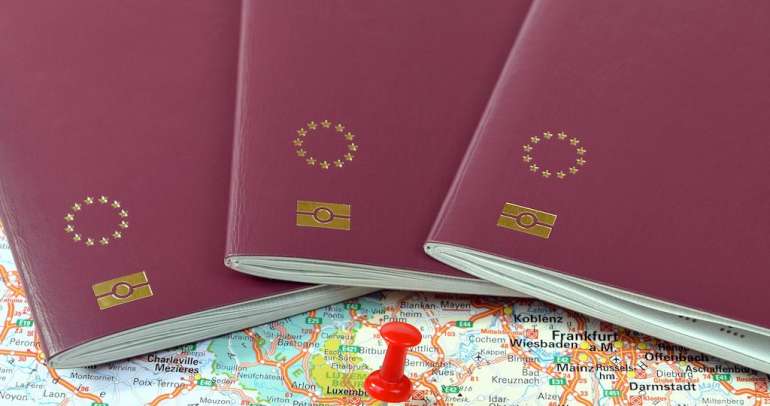Before the First World War, it was possible to travel almost anywhere in the world without a passport, visa, or other official papers. The increase in rail travel passengers crossing borders had led nations to enact laws requiring passports and other official documents that confirmed a person’s citizenship and his or her right to travel abroad. Even refugees needed one.
The two world wars changed travel forever, authorities introducing strict checks in border crossings. The rising popularity of rail travel in the mid-19th century led to an explosion of tourism throughout Europe and caused a complete breakdown in the European passport and visa system. In answer to the crisis, France abolished passports and visas in 1861. Other European countries followed suit, and by 1914, passport requirements had been eliminated practically everywhere in Europe. However, World War I brought renewed concerns for international security, and passports and visas were again required, as a “temporary” measure.
On Oct. 21, 1920, the League of Nations convened a meeting in France for a meeting that would shape modern travel standardizing the passport size, layout, and design for 42 nations.
Introduction of Nansen Passport
The end of World War I saw significant turmoil, leading to a refugee crisis. Numerous governments were toppled, and national borders were redrawn, often along generally ethnic lines. Civil war broke out in some countries. Many people left their homes because of war or persecution or fear thereof. The upheaval resulted in many people being without passports, or even nations to issue them, which prevented much international travel, often trapping refugees. The precipitating event for the Nansen passport was the 1921 announcement by the new government of the Soviet Union revoking the citizenship of Russians living abroad, including some 800,000 refugees from the Russian civil war.
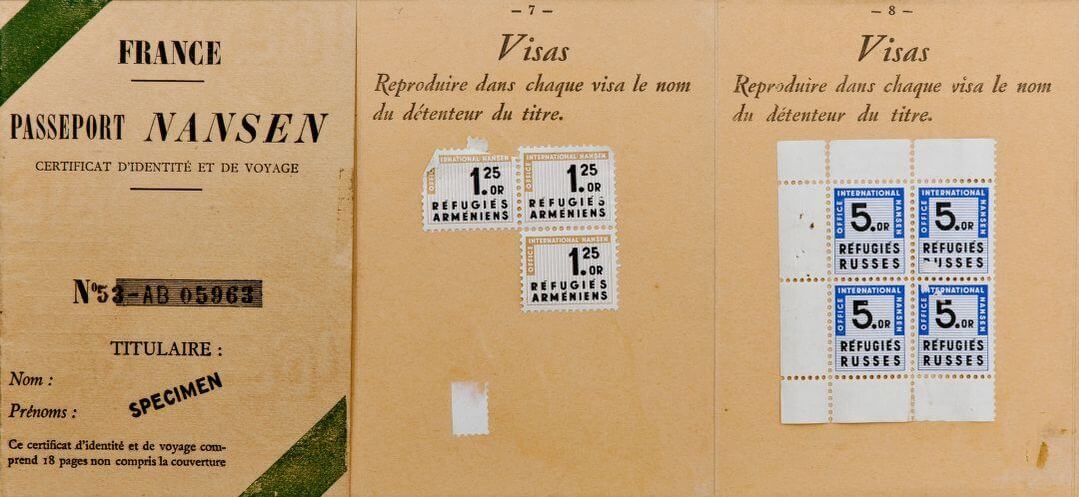
(Above) Nansen passport with armenia and russia visa refugee stamps
Nansen passports, originally and officially stateless persons passports, were internationally recognized refugee travel documents from 1922 to 1938, first issued by the League of Nations’s Office of the High Commissioner for Refugees to stateless refugees. By 1942, they were honoured by governments in 52 countries. The Nansen International Office for Refugees was awarded the 1938 Nobel Peace Prize for its efforts to establish the Nansen passports.
Nazis Weaponizing Passport
On October 5, 1938, the Reich Ministry of the Interior invalidates all German passports held by Jews. Jews must surrender their old passports, which will become valid only after the letter “J” has been stamped on them. The government required Jews to identify themselves in ways that would permanently separate them from the rest of the German population. In an August 1938 law, authorities decreed that by January 1, 1939, Jewish men and women bearing first names of “non-Jewish” origin had to add “Israel” and “Sara,” respectively, to their given names. All German Jews were obliged to carry identity cards that indicated their heritage, and, in the autumn of 1938, all Jewish passports were stamped with an identifying red letter “J”. As Nazi leaders quickened their war preparations, antisemitic legislation in Germany and Austria paved the way for more radical persecution of Jews.
Golden Passports of Haiti
During the holocaust in the 1930’s, there were no citizenship by investment (golden passport) programs. If there were such programs, countless jews would have been saved. One country offered to sell passports to rich jews. This can well be the first golden passport program of the 20th century.
Haiti played a small, yet critical role in saving Jewish lives during the darkest chapter in the Jewish story. In 1937, Haiti was responsible for saving about 70 Jewish families (an estimated total of up to 300 lives) during the Holocaust (according to the American Jewish Joint Distribution Committee), by issuing passports and visas to Jews escaping Nazi persecution. These passports were sold for $3000 to $5,000 (today’s estimate $100,000) fleeing nazi germany to come to Haiti. Some who never came to Haiti at all, but from Germany were given Haitian passports by the Haitian government that allowed them to flee Germany to other countries. The passport allowed safe passport to UK, US and other countries from Haiti.
Haiti at the time was still struggling with exorbitant debt with interest fees to France after the Haitian Revolution[that could have hindered their efforts to continue issuing these passports for free. many of these European Jews stayed in Haiti until the late 1950s in which many Haitian Jews left, In 1957 Jewish population of Haiti was about 200.The mid-20th century was a time where a continued departure of Jews from Haiti for the United States and Panama because of the economic conditions and civil violence in the country. As of 2013, the Jewish population is around 25, predominantly in the capital of Port-au-Prince.
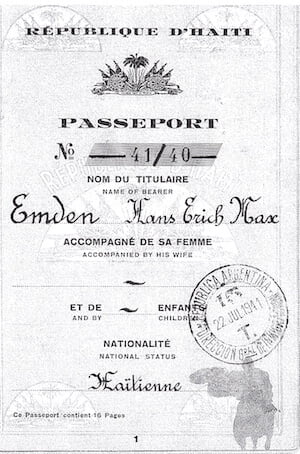
(Above) Passport issued to Hans Erich Max Emden by the Haitian government, who managed to escape the Holocaust. In 1941 he used it to travel to Argentina.
El Salvador
in 1942 the Salvadoran Consulate issued thousands of ”citizenship certificates” to Jews from different parts of Europe. Holders of certificates were considered citizens of El Salvador, and protected by the International Red Cross. El Salvador was the only country offering passports to Jews. They were sent to thousands of Jews in occupied countries across Europe, free of charge, in the midst of the lucrative black market for false papers.
A Struggle for US Visa
How difficult was US visa during holocaust? Between 1938-1941, US law allowed only 27,370 immigration visas per year to be issued to people born in Germany or Austria. In 1938, the waiting times for US visa stretched to 2 years. After September 1940, the US government required two sponsors. Despite all this, a transit visa need to be obtained in order from all the countries you would need to travel through to get to the ship’s port of departure. State Department officials often rejected applicants for economic or national security reasons, or told them to return later with more documents. Many documents and transit stamps had expiration dates, so errors could set you back months and cost a lot of money.
Lados Passports
The Lados group led by Polish diplomats and Jewish activists who during Second World War elaborated a scheme in Bern, Switzerland producing fake Latin American passports (protection papers) to save European Jews from Holocaust. The Lados group acquired blank passports from latin american consuls of Panama, Peru, Honduras, Haiti and El Salvador paying between CHF 500 and 2,000 Swiss francs for each blank passport. . It is estimated 8,000 to 10,000 jews received passports escaping to Latin america.
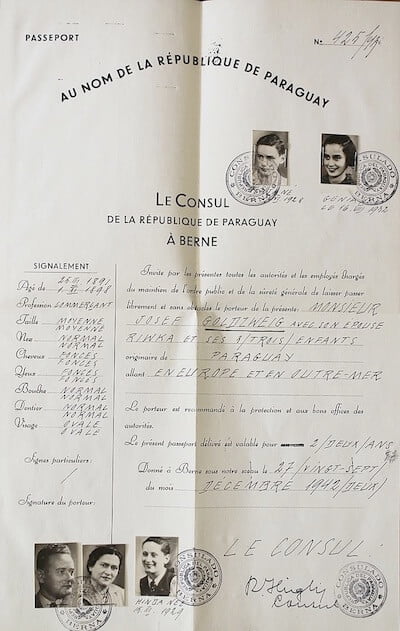
(Above) A forged passport of Paraguay made by the Ładoś Group in 1942 for the Jewish family Goldzweig
Hungary
After the Nazis took over Budapest in 1944, they began deporting Jews to the death camps. Carl Lutz negotiated a special deal with the Hungarian government and the Nazis. He gained permission to issue protective letters to 8,000 Hungarian Jews for emigration to Palestine.
Raoul Wallenberg a young diplomat issued Swedish protective passports to save thousands of Jews in 1944 issuing Yellow Schutz Passports. Wallenberg issued protective passports and sheltered over 10,000 Jews in buildings designated as Swedish territory.
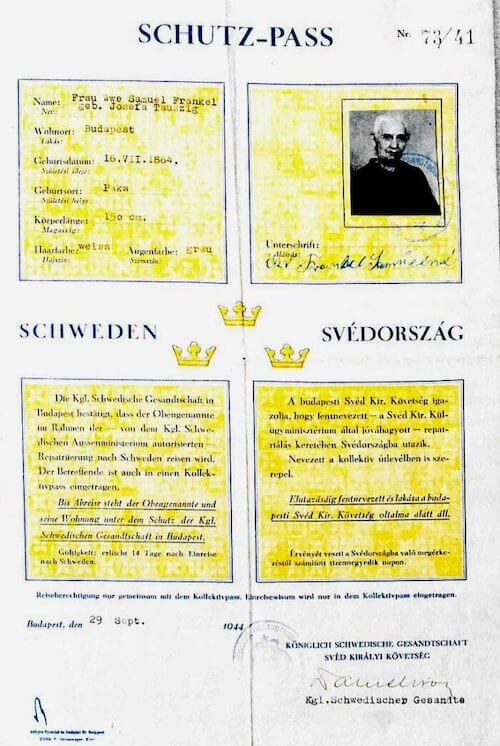
(Above) A Schutz passport is a swedish protective document issued on 29 Sep 1944 in Budapest
Ángel Sanz Briz was a Spanish diplomat who served under Francoist Spain during World War II. He saved the lives of some five thousand Hungarian Jews from deportation to Auschwitz. Between June and December 1944, he and his assistants issued fake Spanish papers to 5,200 Jews, saving them from deportation to concentration camps. he initially received authorization to provide papers to 200 Jews, and continued to enlarge this amount until he reached 5,200.



